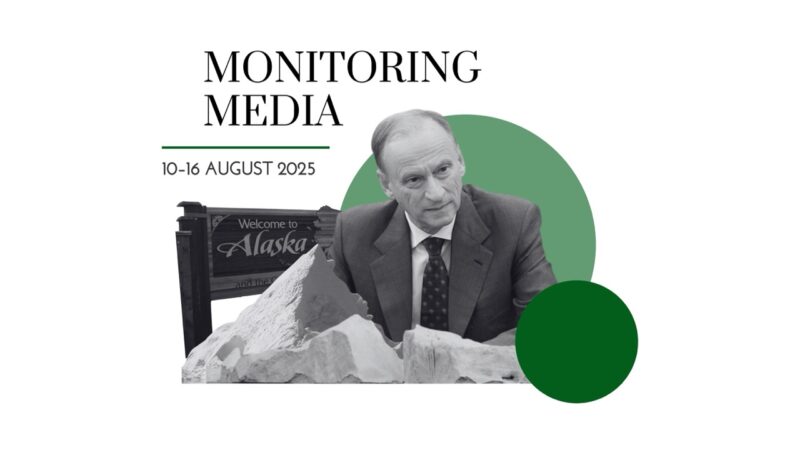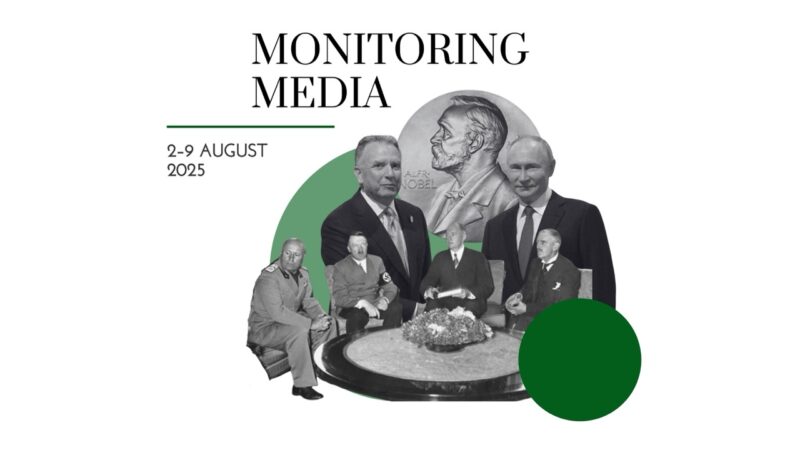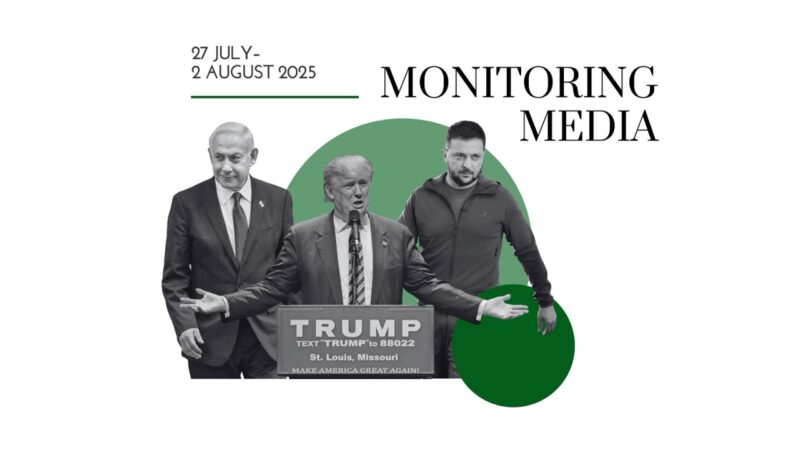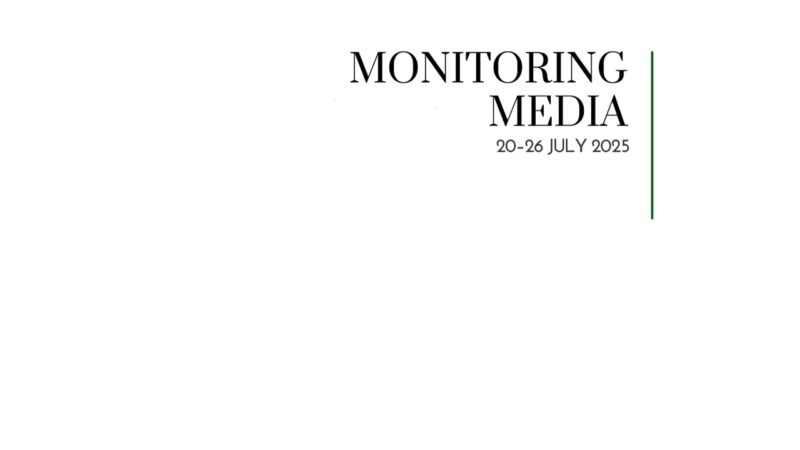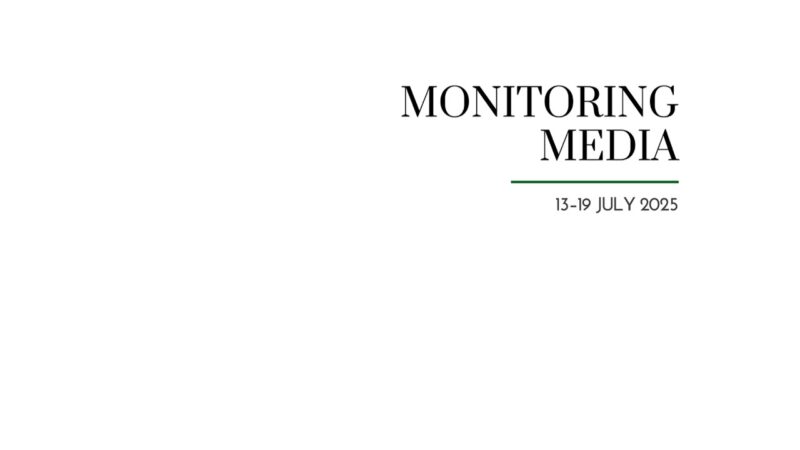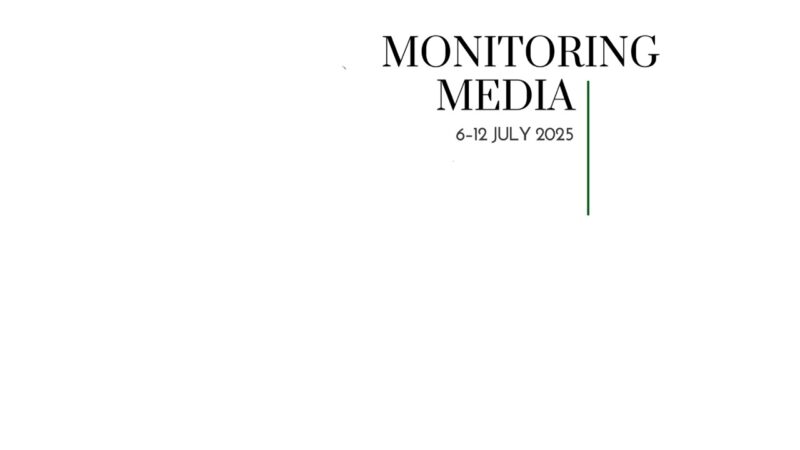Protracted war is exhausting for both sides, but Russians seem better prepared

CIUS weekly report on media coverage of Ukrainian affairs, 27 June–03 July 2022
Three North American magazines (The Economist, The Wall Street Journal, and The New Yorker) were selected to prepare this report on how the situation in Ukraine has been portrayed in media outlets during the past week (27 June–03 July 2022). The sample of magazines was created based on their impact on public opinion, as well as their professional reputation, popularity among the readership, and topical relevance. The three magazines represent the centrist and liberal political spectrum.
This report covers only the most-read articles about Ukraine, as ranked by the respective magazines themselves in the past week. It also covers promoted texts on home pages, texts from special sections on Ukraine, texts from the paper editions of the magazines, and texts about Ukraine from opinion columns and editorials.
Topics featured in the selected articles:
- Ukraine at war: Ukrainians challenge Russia’s domination of the Black Sea; more and more female soldiers join the battlefield; cheap civilian drones can change the tide of war; Ukrainian POWs return home; Ukrainian migrants encounter difficulties in relocating to the UK; pre-invasion volumes of Ukraine’s grain exports will be hard to restore;
- The world and Ukraine: recent strengthening of NATO looks menacing to the Kremlin; NATO may become less supportive of Ukraine as the war progresses; making Russia pay reparations to Ukraine is fraught with political and legal obstacles; Washington promises profound and long-term support to Kyiv; Japan tries not to antagonize Russia in energy relations;
- Russia at war: protracted war works in favour of Russia; war makes little impact on the daily lives of Russians.
The most common arguments:
Ukraine forces Russian retreat from Snake Island. The Economist writes that control over the tiny island in the northwestern part of the Black Sea has been one of Russia’s crucial objectives since the beginning of the invasion: “[the island’s] location overlooking the Danube delta and shipping channels to Odesa and other Black Sea ports makes it a strategic prize. It could also serve as a bridgehead for an amphibious attack on Odesa, some 140 km away.” In this light, Russia deployed (and sacrificed) a lot of resources to establish its presence there, including its flagship Moskva. In turn, for more than four months Ukraine accumulated the necessary firepower to drive the occupier off the island. The successes of the Ukrainians’ assaults in the last weeks of June 2022 were ensured by long-range artillery of high precision. Today, as stated in The Economist, “Ukraine will be in no rush to put its forces back on the rock; it simply hopes to make it impossible for Russia to make any use of the island.”
Ukraine’s female soldiers are often representatives of the middle class and are motivated to defend their national culture against the Russians. The Economist presents the story of Olesia Vorotnyk, a ballerina with the National Opera of Ukraine, who joined the Territorial Defence Forces and helped to evacuate civilians from Kyiv in the first months of the war. Olesia finds many similarities between ballet and military service: both require discipline, training to tolerate pain, and developing one’s strength of mind. When Russia’s war in the Donbas started in 2014, Olesia travelled there to “see the situation with her own eyes. She brought books in Ukrainian to libraries in the east, on subjects of national importance such as the Holodomor.” She thought it was the right thing to do. Five years later she lost her husband in a Donbas skirmish. Olesia highlights that art plays a major role in her personal resistance today. She declares that Russian authorities have always suppressed Ukrainian culture, and the time has finally come to emancipate it. Furthermore, in her opinion performing or praising Russian works of art is morally inappropriate when Ukrainians are suffering in cities occupied by the enemy. Finally, Olesia doubts that Russian soldiers who commit war crimes in Ukraine have ever read Pushkin.
Ukraine successfully uses personal quadcopters for reconnaissance and artillery spotting. According to The Economist, at the very beginning of the invasion, Ukraine’s ministry of defence asked drone owners to donate their devices to the Armed Forces of Ukraine. These drones, totalling several thousand in number, were of crucial importance in repelling Russian troops from northern Ukraine. Today, personal quadcopters are used in the Donbas as sort of advanced binoculars to locate enemy artillery and tank units. However, they have a major drawback: their communications are unencrypted. Apart from bringing them down without authorization, the enemy can hack such drones and redirect return fire. Therefore, after calculating the costs and benefits, US and Israeli military forces invested in the development of protected software for drones. The Economist concludes that “the ubiquitous, cheap drones buzzing overhead in Ukraine may be a vision of future conflicts. Knowing exactly where enemy forces are and what they are doing brings huge advantages. Now there is a simple way to find out.”
In the past week, Ukraine and Russia exchanged the largest numbers of prisoners of war to date. Mauro Orru and Alan Cullison (Wall Street Journal) provide an overview of recent events in the Russo-Ukrainian war. They start with the information from Ukraine’s military intelligence that on 29 June 2022 “144 Ukrainian soldiers were freed, including 95 soldiers who had defended the Azovstal steel plant in Mariupol.” The Russian side even agreed to free soldiers of the Azov regiment, arch-target of the Kremlin’s propaganda. That said, regardless of this exchange the Russo-Ukrainian War is continuing, with neither side willing to step back. Kyiv has appealed to NATO and the UN for isolation of Russia and investigation of its crimes. The Kremlin denies all accusations of war crimes and has simultaneously continued to shell Ukraine with more powerful and less precise missiles. The current skirmish in the Donbas remains extremely brutal, but its artillery advantage allows Russia to slowly conquer new territories. The West needs to deal with the worst crisis in Europe since WWII and respond by upbuilding its military bases on the continent.
Another overview of recent events in the Russo-Ukrainian War is provided by Yuliya Chernova, Ann M. Simmons, Stephen Kalin, and Alex Leary (Wall Street Journal). The analysts examine the pro-Ukrainian resolutions of the NATO summit in Madrid on 28–30 June 2022, the reasons behind Russia’s withdrawal from Zmiїnyi Island, problems with Ukraine’s grain exports, and the Kremlin’s ambition to continue waging war regardless of the costs.
Ukrainians face many unnecessary challenges when seeking refuge in the UK. Anna Russel (New Yorker) writes about a new programme, “Homes for Ukraine,” that allows British benefactors to sponsor Ukrainians who are fleeing the war and host them in their homes. Russel narrates the stories of a teenager, Tymur Sabri, and a bank employee, Yana, both from Kyiv, to demonstrate what people from Ukraine have to endure in order to reach the UK. In particular, Ukrainians need to fill out complicated forms and cover all travelling expenses on their own, which is one reason why few families have settled in Britain compared to elsewhere in Western Europe. Nonetheless, Ukrainians are delighted with the very many signs of solidarity coming from British benefactors. Concurrently, Russel describes the formalities that British host families need to undertake to join the “Homes for Ukraine” programme. The government’s requirements for the premises accommodating Ukrainians, as well as for the backgrounds of the benefactors, are onerous. Moreover, the Ukrainians are not treated as refugees; they are admitted within a managed migration route and lack the same protections as refugees. Therefore, if Ukrainians are asked to leave by their sponsors, as sometimes happens, it makes them literally homeless in a foreign country.
With its seaports blocked, Ukraine has run out of options for storing its grain. The Economist writes that “Ukraine provides 10% of the world’s wheat, 16% of its maize and roughly half of its sunflower oil.” However, with Russia’s naval blockade, damaged elevators and storehouses, and Ukraine’s very modest railway transport capacities, local farmers face the critical question of what to do with their new harvest. The Economist highlights that “some farmers would rather hoard grain in the hope that ports will eventually reopen than see expensive transit to Poland or Romania eat into their margins.” However, storing harvested crops in the open air is never a good solution, as they may rot or get stolen. In turn, the government is “ordering mobile storage facilities, which can be set up in fields to shelter grain from the elements and pests.” International partners are also lending a hand by building temporary silos on the Polish-Ukrainian border. This said, the general picture does not bode much hope; and to avoid significant losses, Ukraine’s farmers are considering either switching to more transportable crops or not planting anything at all.
Mines along sea routes are a major obstacle to freeing Ukraine’s grain exports. Matthew Luxmoore, Alistair MacDonald, and Nancy A. Youssef (Wall Street Journal) write that “before Ukraine can begin exporting grains via the Black Sea, mines have to be cleared, warehouses patched up and shipowners persuaded to take the risk of making the journey.” These activities require a profound multilateral effort, with the UN taking the lead in negotiations between Kyiv and the Kremlin, and NATO ensuring the security of navigation. However, even if the negotiations between the belligerents were successful, it would take months to get traffic moving again. Minesweeping of the northwestern Black Sea littoral will be challenging, as both Ukraine and Russia weaponized it abundantly—the latter to prevent Ukraine’s warships from leaving ports and the former to minimize the risks of Russia’s amphibious landing on its shores. Apart from this, the Kremlin should provide guarantees that its navy will neither threaten Ukraine’s territorial waters nor attack merchant vessels, as happened in the first days of the escalated invasion. Last but not least, Ukrainian ports need to restore their peacetime functionality (which also includes the liberation of four ports from under Russian occupation).
The West should exploit the Kremlin’s fear of conflict with NATO and put more pressure on Russia. Holman W. Jenkins, Jr., (Wall Street Journal) argues that the Kremlin wants to avoid a confrontation with the Alliance by all means necessary, as it would lead to Russia’s eventual defeat. Therefore, it has done little to counterweight NATO’s actions after 24 February 2022, neither disrupting the supplies of Western weaponry to Ukraine nor actively preventing the integration of Sweden and Finland into NATO. In this vein, the Kremlin would probably not respond with force even if NATO deployed its warships to unblock Ukraine’s ports and restore grain exports. In fact, the current Western panic over grain exports is sending the wrong signal to Russia. It not only encourages the Kremlin to take a tougher stance on Ukraine but misrepresents reality, as the Western market economies have largely re-adjusted themselves to accommodate the losses from sanctions on Russia and mitigate the global food crisis. The West is not as susceptible to the Russian power-play as the Kremlin would like to imagine; Jenkins encourages readers to keep this in mind when pondering a resolution to the Russo-Ukrainian war.
NATO may not be as united in its stance against Russia as it wants to appear. Robin Wright (New Yorker) starts his article with the statement that “in Madrid this week, NATO laid out a bold plan for military expansion in response to Putin’s war.” Wright highlights that the West, for the first time since the collapse of the USSR, has switched from cooperation to confrontation with the Kremlin. This anticipates increases in both troop numbers and military budgets across European states, a greater US presence in Central and Eastern Europe, and declarations to support Ukraine “as long as it takes” in beating back the Russian invasion. At the same time, Wright raises the question of how long NATO members will be able to manage political tensions at home and remain loyal to their commitments; he claims that “key NATO governments are individually weak.” For instance, public support for Joe Biden, Boris Johnson, Olaf Scholz, Emmanuel Macron, and other leaders of the West is shrinking. At the same time, Hungary and Turkey are backsliding into authoritarianism, contradicting NATO values. Therefore, if the Kremlin plays its “disrupt domestic policy” game well, the ambitious plan of the Alliance to support Ukraine may only partially work.
Western enforcement of Russia’s reparations to Ukraine will be legally and politically difficult. Jillian Kay Melchior (Wall Street Journal) presents findings of the Kyiv School of Economics Institute that quantify the damage Russians have inflicted in Ukraine: “As of June 8, Russia had wrought $103.9 billion in direct damage on Ukrainian buildings and infrastructure…the quantity of housing destroyed is the equivalent of 5% of the country’s houses and apartments. As many as 105,000 vehicles are wrecked, and the war has ravaged some 14% of Ukraine’s roads. Ukraine has lost more than a fifth of its healthcare facilities.” In this light, Western states, and specifically the US, could use already seized financial assets that belong to Russian subjects and redirect them toward Ukraine’s reconstruction. The precedent already exists: in the 1990s, under UN supervision, Iraqi oil revenues were redirected to Kuwait, which had suffered under Saddam Hussein’s invasion. However, in the case of today’s Ukraine, Russia is likely to use its veto power in the UN Security Council to prevent the utilization of its money for Ukraine’s relief. Also, “given America’s extensive due-process protections, these cases would take years if not decades to adjudicate.”
Japan does not want to start a bilateral energy confrontation with Russia. The Economist examines the case of Sakhalin, which has historically often been the site of conflict between Japan and Russia. Today the island is home to two massive fossil-fuel projects, where international equipment and capital were engaged before Russia’s invasion of Ukraine. Following the invasion, American and British investors sold their shares and left. In turn, the Japanese decided to stay and are not expected to “leave even if asked to by the Russian government.” There are a few reasons for this. Primarily, if Japan forfeits its shares in the projects, the probable new stakeholders will be China and/or India. Both are competitors to Japan in the region who would significantly benefit from purchasing attractive shares at a dumping price. Secondly, Japan is very heavily dependent on Russian gas exports, specifically those coming from Sakhalin. The options for energy diversification are scarce, unlike in the EU. This also partially explains why the government in Tokyo has demonstrated little enthusiasm in joining the Western energy sanctions against Russia.
Russia is better prepared to endure the calamities of war. The Economist and Wall Street Journal offer their analyses of the current stage of war. Three published articles on the topic conclude that protracted war works in favour of Russia, not Ukraine.
The first article in The Economist argues that Russia possesses more resources to fight, which makes it feel more confident on the battlefield: “A long war suits Russia. Both sides are using huge amounts of ammunition, but Russia has vastly more. The Russian economy is much larger than Ukraine’s and in far better shape. In pursuit of victory, Russia is willing to terrorise and demoralise the Ukrainians by committing war crimes, as it did by striking a shopping mall in Kremenchuk this week. If needs be, Mr Putin will impose grievous suffering on his own people.” This said, Ukrainians managed to win the first stages of the war and seem to possess what the Russians are lacking: fighting spirit and motivation. With increased supplies of Western weaponry, Ukrainians have a good chance to liberate currently occupied territories. The variables in question are time and human sacrifice, as Putin aims to “take as much of Ukraine as he can, declare victory, and then call on Western nations to impose his terms on Ukraine. In exchange, he will spare the rest of the world from ruin, hunger, cold, and the threat of nuclear Armageddon” by returning to business as usual. The Economist argues that accepting Putin’s blackmailing would be a historic error and would provide only a temporary solution to the problem of Russian expansionism.
A second article in The Economist advocates that changing the nature of the war from “blitzkrieg” to “protracted” remains in Russia’s favour. The latter belligerent came more prepared for war: its economy has been stably developing for the past decade, the quantities of stored weaponry and weapons-producing facilities are incomparably higher than in Ukraine, the Kremlin planned the invasion much in advance, and its propaganda machine has worked more effectively to promote wide-scale conscription for the army. In contrast, Ukraine’s defence is significantly dependent on the individual sacrifices of its citizens and the goodwill of the Western powers to provide arms and financial support. The Economist concludes that “the longer the war goes on, and the higher the cost in terms of punishing energy prices and decelerating economies, the more reluctant Ukraine’s allies will become to provide endless weapons and cash. Mr Putin, for one, seems to be counting on the West’s resolve to crumble.”
In turn, Stephen Kalin (Wall Street Journal) emphasizes that a war of attrition places a heavy toll on the defenders: “Ukraine has made the invading forces pay dearly for every patch of land they seize…By holding out, the Ukrainians are winning time for their military to rush more modern and powerful weapons… [however,] as soldiers hold on by sheer will, questions are emerging as to which side will be exhausted first.” Kalin builds his article on stories from Ukraine’s “Captain Bohdan” and from a soldier, “Yuriy,” who describe the horrors of war, from surviving night raids and tank shelling to crossing a river in a rubber dinghy under gunfire. Due to its comparative dearth of heavy artillery, the Ukrainian side cannot effectively fight back and needs to constantly withdraw and regroup. This kind of manoeuvrable defence exhausts Russian resources, but it often proves to be costly in light of their superior firepower. This said, Ukrainian defenders are willing to remain on the front lines as long as needed until Western weaponry arrives.
Residents of Russia’s biggest cities feel no reverberations from war. Evan Gershkovich (Wall Street Journal) argues that “as the invasion of Ukraine enters its fifth month, there are relatively few outward signs in Moscow and St. Petersburg of a war that has killed thousands and displaced millions.” A few changes that Gershkovich notices are the absence of foreigners on the streets, the flight of global brands from shopping malls, the abundance of “Z” and “V” letters on buildings, and billboards glorifying Russian soldiers. That being said, the numbers of military casualties among residents of Moscow and St. Petersburg are negligible in the context of Russia’s overall casualties; very few have experienced people close to them dying or disappearing without a trace. Therefore, the residents of big cities continue enjoying their lifestyles; the war has become a background noise, similar to the USSR’s fight in Afghanistan in the 1980s. Moreover, popular support throughout Russia for the military aggression and Putin’s decisions remains comparatively high, not least because the war does not directly impact the Russian middle class. As one of Gershkovich’s respondents stated, “fighting is for soldiers. I protect my little world and nothing else concerns me.”
